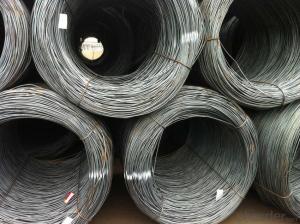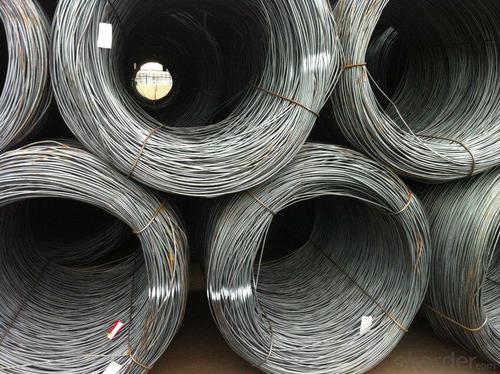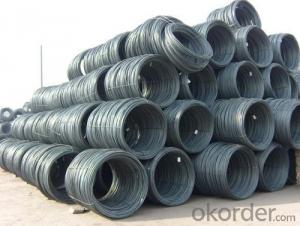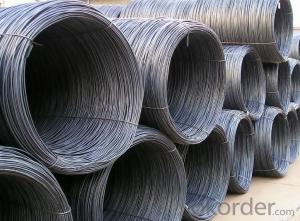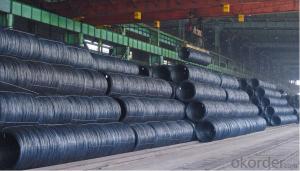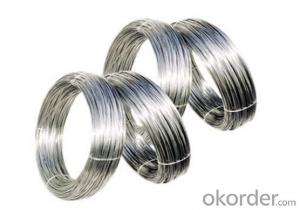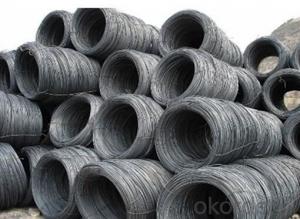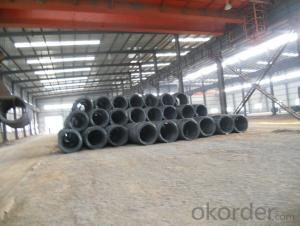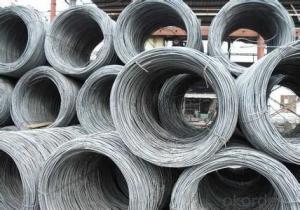Supply 8.5mm steel wire rod with competitive price
- Loading Port:
- Tianjin
- Payment Terms:
- TT OR LC
- Min Order Qty:
- 25 m.t.
- Supply Capability:
- 500000 m.t./month
OKorder Service Pledge
OKorder Financial Service
You Might Also Like
Specification
Steel Grade: Q195/235, SAE1006-1018B Standard: ASTM, GB
Diameter: 5.5mm, 6.5mm, 7mm,8mm,9mm,10mm,12mm,14mm
Type: Drawn Wire Alloy or Not: Alloy Brand Name: HSKY
Technique: Hot Rolled Place of Origin: China Mainland
Chemical Composition:(Please kindly find our chemistry of our material based on SAE1006B and SAE1008B as below for your information)
High carbon/Low carbon/common carbon Steel wire rod | With boron for rebate tax |
Grade | SAE1006B SAE1008B SAE1018B |
Package | In coil ,in bundle, |
Coil weight | about 2000kg-3000kgs |
Size: | 5.5mm 6.5mm 8mm 10mm 12mm 14mm 16mm |
Types | High Carbon ,Low carbon ,Common carbon |
Exported Country | South Korea,Vietnam,Indonesia,Myanmar,Philippines and Afrca,Ect |
Delivery term: | within 30 days after receive the LC |
Payment Term: | LC at sight ,LC 30-120 days after B/L date, TT payment |
The Standard of Physical Properties:
Grade | Chemical Composition(%) | |||||
C | Mn | Si | S | P | Cr | |
SAE1006 | 0.03~O.07 | ≤0.32 | ≤0.30 | ≤0.045 | ≤0.040 | >0.30 |
Mechanical properties | ||||||
Yield strength(N/mm2) | Tensile strength(N/mm2) | Elongation(%) | ||||
250-280 | 350-380 | ≥32 | ||||
Grade | Chemical Composition(%) | |||||
C | Mn | Si | S | P | Cr | |
SAE1008 | 0.10max | 0.3~O.50 | 0.15max | 0.050max | 0.040 max | 0.30 min |
Mechanical properties | ||||||
Yield strength(N/mm2) | Tensile strength(N/mm2) | Elongation(%) | ||||
≥195 | 315-430 | ≥30 | ||||
Usage and Applications of Steel Wire Rod in Coil:
After hot-rolled the products shaped into coil and delivery as finished product, including round, square, rectangular, hexagonal and so on, Since most of the products are round, it is generally called wire rod. Steel wire rod is widely used in construction and manufacturing. Steel wire rod is mainly used for reinforcement of reinforced concrete and welded structure or reprocessed (roberts, nail etc) materials, especially used to produce wire drawing, welding electrode, nails,spring, electronic, precise machinery parts and so on.
Packaging & Delivery of Steel Wire Rod in Coil:
Packaging Detail: products are packed in coil and then shipped by container or bulk vessel
Each coil weight: 2-3MT
Delivery Detail: within 45 days after received deposit or LC.
Label: to be specified by customer, generally, each bundle has 1-2 labels
Trade terms: CFR, CIF
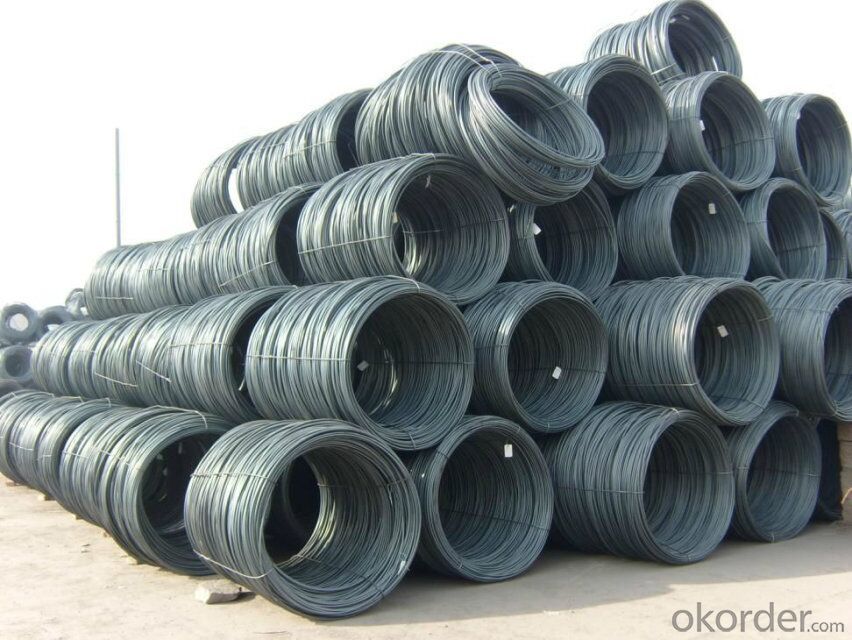
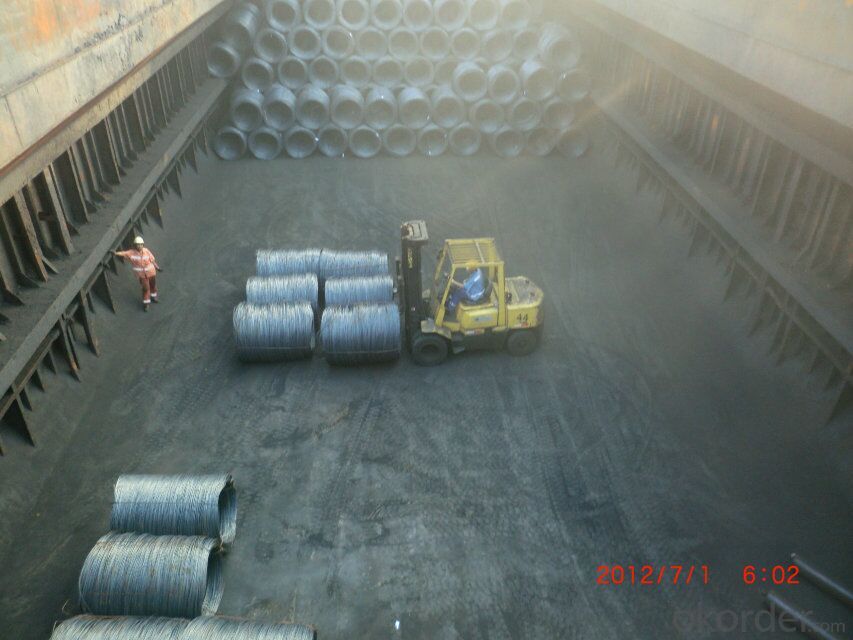
- Q: How is steel wire rod used in the manufacturing of wire for agricultural fences?
- Steel wire rod is an essential raw material in the manufacturing of wire for agricultural fences. It serves as the primary material that is drawn, twisted, and coated to create the final wire product. The high tensile strength and durability of steel wire rod make it ideal for withstanding the harsh conditions and stress that agricultural fences are subject to. Additionally, the flexibility of steel wire rod allows for easy installation and ensures that the wire can be securely fastened to fence posts.
- Q: How is the steel wire rod industry affected by fluctuations in raw material prices?
- The steel wire rod industry is significantly affected by fluctuations in raw material prices. Raw materials, such as iron ore, coal, and scrap metal, are essential for the production of steel wire rods. Any changes in the prices of these raw materials can have a direct impact on the cost of production for steel wire rod manufacturers. When raw material prices increase, it directly increases the input costs for steel wire rod production. This puts pressure on manufacturers to either absorb the higher costs, which can lead to reduced profit margins, or pass on the increased costs to customers through higher prices. In either case, it can impact the competitiveness of steel wire rod manufacturers in the market. On the other hand, when raw material prices decrease, it can provide some relief to steel wire rod manufacturers as it reduces their production costs. This can enable manufacturers to offer lower prices or maintain their profit margins while remaining competitive in the market. Fluctuations in raw material prices also affect the supply chain of the steel wire rod industry. Manufacturers rely on a steady supply of raw materials, and any disruption or volatility in prices can impact their ability to procure sufficient quantities of raw materials. This can cause delays in production, lead to higher inventory costs, and affect the overall productivity of the industry. Additionally, fluctuations in raw material prices can also impact the profitability of steel wire rod manufacturers. If raw material prices increase significantly and manufacturers are unable to pass on the increased costs to customers, it can result in reduced profitability and potentially even financial losses. Conversely, when raw material prices decrease, manufacturers may experience improved profitability. In conclusion, fluctuations in raw material prices have a direct impact on the steel wire rod industry. It affects the cost of production, competitiveness, supply chain, and profitability of manufacturers. As a result, industry players closely monitor and analyze raw material price trends to make informed decisions and mitigate the impacts of price fluctuations.
- Q: What are the common documentation requirements for steel wire rod?
- The common documentation requirements for steel wire rod typically include the product specifications, test certificates, mill certificates, packing lists, and shipping documents such as bills of lading or airway bills. These documents provide crucial information about the quality, origin, and shipment of the steel wire rod, ensuring transparency and compliance with industry standards.
- Q: What are the different surface finishing materials used for steel wire rod?
- There are several surface finishing materials that are commonly used for steel wire rod. Some of these materials include zinc, copper, nickel, and chrome. These finishes are applied to the steel wire rod to enhance its corrosion resistance, improve its appearance, and provide additional functionality such as improved conductivity or lubricity.
- Q: How is steel wire rod used in the manufacturing of wire forms for aerospace applications?
- Steel wire rod is used in the manufacturing of wire forms for aerospace applications as it provides high strength and durability, making it suitable for critical components. The wire rod is first drawn through a series of dies to obtain the desired diameter and then undergoes various shaping processes such as bending, coiling, or twisting to create intricate wire forms. These wire forms are used in various aerospace applications such as aircraft seating, control systems, and structural components due to their ability to withstand high loads and maintain their shape even under extreme conditions.
- Q: What are the main factors affecting the customer satisfaction with steel wire rod?
- The main factors affecting customer satisfaction with steel wire rod include the quality and consistency of the product, its strength and durability, the ability to meet specific requirements and specifications, on-time delivery, competitive pricing, responsive customer service, and overall customer experience with the supplier.
- Q: What are the common production processes for ruthenium-coated steel wire rod?
- The common production processes for ruthenium-coated steel wire rod typically involve several key steps. First, the steel wire rod is usually cleaned and prepared to remove any impurities or surface contaminants. Next, a coating material, in this case, ruthenium, is applied to the surface of the steel wire rod using various methods such as electroplating or chemical vapor deposition. This coating process helps improve the wire rod's corrosion resistance, durability, and other desired properties. After the ruthenium coating is applied, the wire rod is typically inspected for quality and undergoes any necessary finishing processes, such as annealing or polishing, to achieve the desired final product.
- Q: What are the common welding techniques for steel wire rod?
- Different welding techniques are used for steel wire rods depending on the specific application and desired outcome. Some commonly used techniques include: 1. Gas Metal Arc Welding (GMAW), also known as MIG welding, utilizes a consumable wire electrode and shielding gas to create a weld. GMAW is popular for its versatility, ease of use, and ability to produce high-quality welds when working with steel wire rods. 2. Gas Tungsten Arc Welding (GTAW), also known as TIG welding, involves a non-consumable tungsten electrode and shielding gas to create a weld. GTAW is often employed for precision welding applications that require precise control and a visually appealing weld. 3. Flux-Cored Arc Welding (FCAW) uses a tubular wire electrode with a flux-filled core. The flux serves as a shielding gas and aids in removing impurities from the weld zone. FCAW is suitable for welding steel wire rods outdoors or in windy environments where the shielding gas of GMAW or GTAW may be compromised. 4. Shielded Metal Arc Welding (SMAW), also known as stick welding, employs a consumable electrode coated in flux. The flux generates a shielding gas and assists in removing impurities from the weld zone. SMAW is a versatile and portable welding technique commonly used for steel wire rods in various applications. 5. Resistance Welding involves passing an electric current through the steel wire rods to create resistance and generate heat, fusing the materials together. Resistance welding is commonly utilized for high-speed production welding of steel wire rods, such as in the manufacturing of wire mesh or fences. It is crucial to select the appropriate welding technique based on factors such as the type of steel wire rod, desired weld strength and quality, welding environment, and available equipment and resources.
- Q: How does the elongation of steel wire rod vary with different wire drawing processes?
- The elongation of a steel wire rod can vary depending on the specific wire drawing process employed. Different processes, such as cold drawing or hot drawing, can impact the elongation of the wire differently. Cold drawing typically results in higher elongation as the wire is pulled through a series of dies at room temperature, causing the metal to stretch and elongate. On the other hand, hot drawing involves heating the wire rod before drawing it through the dies, which can result in lower elongation due to the higher temperature softening the metal. Additionally, the speed and force applied during the drawing process can also affect the elongation of the steel wire rod.
- Q: How is steel wire rod used in the manufacturing of wire mesh partitions?
- Steel wire rod is used in the manufacturing of wire mesh partitions as it serves as the primary raw material for creating the mesh. The steel wire rod is first formed into individual wires, which are then woven or welded together to form the mesh pattern of the partition. This mesh structure provides strength, durability, and security to the partition, making it suitable for various applications such as creating secure storage enclosures, dividing workspaces, or enhancing safety in industrial settings.
Send your message to us
Supply 8.5mm steel wire rod with competitive price
- Loading Port:
- Tianjin
- Payment Terms:
- TT OR LC
- Min Order Qty:
- 25 m.t.
- Supply Capability:
- 500000 m.t./month
OKorder Service Pledge
OKorder Financial Service
Similar products
Hot products
Hot Searches
Related keywords
